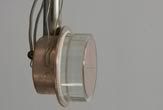Hum,
here one i had made earlier...
The lithium tantalate (LiTaO3) pyroelectric crystal, is bathed in deuterium gas, and one side touches a copper disc. (The setup was then cooled to -33ºC and then heated to about 7 ºC for three and a half minutes.)
 Blowup
BlowupA tiny tungsten probe (you can just see it as a line in the picture) is placed at the centre of the copper disc.
When the crystal is subsequently heated, a very large electric field is produced at the end of the tungsten tip, about 25 billion volts per metre.
(The crystal is asymmetric and, as a result, heating the material causes positive and negative charges to migrate to opposite ends of the crystal, setting up an electric field. The phenomenon is known as the pyroelectric effect.)
This field gradient is so high (10e7 electron volts) that it strips the electrons from nearby deuterium atoms. The ionised deuterium atoms then accelerated by this field towards a solid target of erbium deuteride (ErD2).
They collide with it at such high energies that some fuse with the target. A measurement of almost 900 neutrons per second was observed. This is 400 times the background count! Although the amount of energy produced in this initial experiment was miniscule (~1e-8 joules).